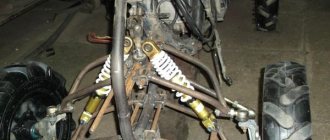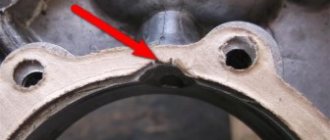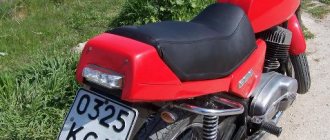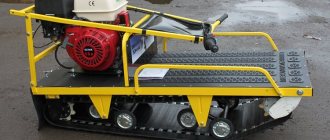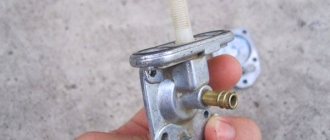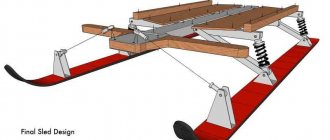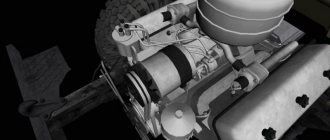Do-it-yourself scooter tuning - remove limiters, plugs and choke and improve driving performance
We increase engine power, improve driving performance, and make the scooter more attractive on the road. And we do it all with our own hands.
In our country, scooters are a fairly popular two-wheeled vehicle that occupies the minds of young people, as well as older men and women. It is not surprising, because there is no longer such a miniature, economical and convenient in many ways transport, at a reasonable price. However, despite its modest dimensions and tiny engine, the scooter can also be quite fast. In this article we’ll talk about scooter tuning, what it is like and how much it costs?
A way to increase the engine capacity of a Chinese scooter
Chinese-made scooters with a small engine capacity of 50 cm3 are completely sluggish and gain momentum in a boring way. They are not even close to Japanese small-capacity scooters, which are distinguished by their agility, but increase the engine capacity of a Chinese scooter without any problems, and we will outline in this article how this can be done correctly, using the most radical method.
We will talk about how to replace the standard 49.9 cm3 piston with a more powerful one - 82 cm3. In today's world of motorcycles, increasing the piston of Chinese scooters is almost the most popular tuning that can be done at an affordable price. But in Japanese scooters, a special volume is recommended for proper engine operation, which is limited to 65 cm3. But Chinese scooters are also distinguished by the fact that they cope with this process more calmly and the 82cm3 CPG - they eat with a bang, and are also easy to set up and provide excellent engine performance, while being much better in traction, increasing speed and dynamics.
How to get the most out of a scooter with tuning?
Scooter tuning is a fairly extensive process, but consists mainly of styling (improving appearance), chassis tuning (modifying driving characteristics) and engine tuning. The last point consists of many different operations that are aimed at increasing engine power, its better implementation and increasing acceleration and maximum speed. Below we will consider modifications to the engine and transmission.
It’s worth noting right away that the scheme is general and suitable for Italian, Japanese and Chinese models. Those who doubt the quality of Chinese scooters should be reminded that the level of production of modern models from the Middle Kingdom has increased significantly over the past 10 years, and most of the spare parts on the market for all models are from Chinese manufacturers.
There are many ways to speed up your scooter and, first of all, they depend on the current technical condition of the unit. Let's take, for example, an old scooter with an incorrectly configured variator, a clogged air filter, a dirty carburetor and a number of other problems that arise when the equipment is not properly maintained. Such an engine has great potential, but it can only be realized after proper tuning. After thorough cleaning and adjustment of all systems, even standard engine performance will seem like a significant improvement.
It follows that any work aimed at improving driving performance must begin with a complete revision of the engine.
Removing factory limiters is a very popular type of tuning and quite simple. Most of the Japanese equipment and similar Chinese equipment comes from the factory with special limiters that do not allow the engine to operate at full power. Fortunately, you can get rid of restrictions in any garage, and any tuning of a scooter with your own hands begins with the elimination of such restrictions.
When childhood illnesses are over, it is worth paying attention to real tuning, namely, improving or modifying existing components and assemblies. We are talking, of course, about the cylinder-piston group, carburetor, muffler, variator, air filter and ignition system. At this stage, the degree of involvement in improving a particular element depends on the budget. If funds are limited, then we will make the most of the existing set by modifying the described units.
If you have a certain budget for tuning, you can go the route of replacing parts with special tuning ones. Special parts designed for such modifications automatically improve the basic characteristics of the engine, plus they are designed for higher loads. We have figured out the general scheme of improvements, and below we will look at how tuning occurs, using examples of specific components.
How to increase engine capacity on a Chinese scooter
Today, increasing the piston is the most popular tuning of Chinese scooters for relatively little money, and this is obvious. Unlike Japanese scooters, where the maximum recommended volume for normal engine operation is limited to 65 cm3, Chinese scooters are more loyal to this procedure and perfectly digest 82 cm3 CPG, are easy to set up and work great, showing significant improvements in traction, speed and dynamics. If you have a Chinese two-stroke scooter, limit yourself to a 65cc piston.
Where to start tuning the engine on a Chinese four-stroke scooter? Naturally, with the purchase of the necessary CPG kit. Initially, you need to figure out which engine is installed on your scooter and, based on this, order a piston engine specifically for a specific model. In 90% of cases, Chinese scooters are equipped with a 139QMB engine. If you have one, you are in luck. At least there will be no problems with spare parts. Finding a larger-volume piston for these engines is very easy, for example, here: CPG 82cc 139QMB. I am glad that the stores are also stocked with spare parts for these CPGs, and this eliminates all sorts of problems with finding spare parts during operation, for example, rings, piston, etc.
So, the new CPG is in your hands. It remains to make a difficult choice: replace all the parts yourself, or entrust this work to the masters at the service station? It should be noted that there is nothing complicated here; if you have never repaired a scooter before, you should still start. A huge number of videos have been shot on this topic and many lessons have been written. We will not review the entire process of replacing the piston; we will only mention the main points that are important to remember:
— There is no need to remove the engine block. The Chinese made sure that engine repairs could be carried out without removing it from the frame, but limited to only removing the toilet and some plastic elements. It is very comfortable. Many Japanese scooters do not allow this and only scooters of the Honda Lead or Dio subtype provide free access to the piston on the scooter, freely standing on the central leg. As you know, the 139QMB engine was also developed by Honda, so you shouldn’t be surprised at the ease of maintenance and repair. — After removing the toilet and plastic, we proceed to removing the engine casing, after which we unscrew and release the air filter pipe and the filter box itself. Before this, you need to blow with compressed air and clean all dirt from the carburetor and cylinder cooling fins. — Unscrew the exhaust pipe fastening and move it to the side. — Unscrew the bolts securing the intake pipe and move the carburetor to the side. — Disconnect the high-voltage wire and unscrew the spark plug. — Carefully unscrew the cylinder head cover bolts, then remove the mechanism with the rocker arms. We move the chain to the side. — Alternately, in several stages, unscrew the cylinder head mounting bolts and remove the head. - Now, if the cylinder sits tightly on the gasket, you can move it out of place with a small wooden mallet, gently tapping it. After this, the cylinder can be easily removed, allowing access to the piston. — Now we remove the old piston from the connecting rod and install a new, larger one. How to replace the piston on a Chinese four-stroke has already been discussed, we will not repeat it. — Next, we put the new cylinder and head in place and reassemble it in the reverse order. We check the valve clearance setting and the correct installation of the timing system.
After assembling the engine, it is recommended to change the engine oil, check the air filter and adjust the carburetor. Good results are observed when raising the spool needle one notch in order to slightly enrich the mixture.
If after this the engine refuses to work or operates incorrectly, check the timing belt setting; usually at this stage, beginners make mistakes during assembly.
Source
We remove the engine.
Specialists, experts or garage technicians begin tuning a scooter with their own hands by dismantling the factory limiters. They are necessary to, firstly, keep the equipment within the established speed limits (Japanese models), and also to increase the service life of the motor. The problem is that you can find this element only after studying your engine model on various forums. The reason for this is the different locations of these same limiters, it could be a blind fork in the exhaust, an electronic limiter installed on the variator or even in the carburetor.
- Plug in the variator. In this case, the part is a special plate mounted on the side of the weights. It prevents the belt from reaching its maximum radius, which means it is impossible to achieve the maximum possible speed. If you have such a part, then by removing it you can significantly increase the maximum speed.
- Limiter in the variator. Sometimes the limiter is the lip on the bushing itself; here you cannot do without the work of a turner. By loosening the limiting edge of the variator, you can increase the speed. Also for many models a ready-made, bored part is sold.
- Carburetor. In this assembly, the plug looks like a valve. With a significant increase in pressure, it opens, thereby preventing the full entry of the air-fuel mixture into the combustion chamber. This can all be treated as in previous options - by dismantling the element or replacing the entire part.
- Exhaust. An interesting restriction system is located in the exhaust. It represents a branch where one of the channels is a dead end. Thus, turbulence and internal pressure in the exhaust increase, which prevents high-quality purging of the combustion chamber. The problem can be solved by brewing dead-end branches.
- Electronic system. Finally, the switch limiter can be considered the most advanced by modern standards. Some Chinese and Italian models can be deceived by cutting the limiter wire, for this you will have to study a lot of literature on electrical engineering. Other models get rid of the problem by simply replacing the unit.
We adjust valves (4t engines).
As mentioned earlier, the engine must be serviced before boosting. Work that will help improve dynamics includes adjusting the valves. The procedure is suitable for tuning Chinese 4t scooters and other 4-stroke engines. For small-capacity equipment, it is recommended to carry out such adjustments at least once every 3, and preferably once every 2 thousand km. It is also necessary to carry out adjustments after manipulations with the CPG.
Before you begin, you need to make sure that the engine has completely cooled down and that you have a set of keys (8,9) and feelers of 0.05 for the intake valve and 0.07 mm for the exhaust valve at hand. You can get to the adjusting nuts by first removing the valve cover. When access to the valves opens, the piston is installed at top dead center. Next, a feeler gauge is installed in the intake valve gap and, depending on the current position, an adjustment is made.
To increase or decrease the clearance, you need to loosen the lock nut (while holding the adjusting bolt), turn the adjustment bolt and, while holding it, tighten the lock nut back. Thus, we achieve a gap when the probe passes into it with little effort. After adjustment, make a full revolution of the crankshaft and make sure that the adjustment is accurate.
Tuning the carburetor and air filter.
The basic principle of driving fast is to burn more gasoline per unit of time, it is suitable for tuning Chinese 4t scooters, Japanese 2t scooters and any other models and types of engines, and the carburetor helps in this, first of all. You can modify the standard unit by installing more efficient jets, but in practice it is better to install more efficient models. Scooter tuning is made easier due to productive models of carburetors produced by DellOrto, a set of pipes and other accessories for them.
A high-performance carburetor will deliver more fuel to the cylinder, and more fuel requires more air. Therefore, the standard filter should be reviewed; it is best to replace the filter element with a new one, while making sure that the entire system is tight. If you are preparing a high-power device, it makes sense to install a minimum resistance filter, but do not forget that it requires constant care, otherwise the filter element will dry out and sand will begin to get into the engine.
1 Classification of motors and upgrade options
Today, scooters are available with several types of motors. The most popular version of a small cc engine is the Chinese model 139qmb with a displacement of 49.6 cc. Next comes the 153QM model with a volume of 150 cm3 and the 157QMJ with a volume of 150 cm3. Thus, within each type of Chinese motor, the main engine parts are in principle interchangeable. This means that finding parts becomes an easy task.
Previously, the most popular scooter tuning kits were “whales” from Italian manufacturers Pallinni, Mallossi or Metrakit. These tuning kits, as a rule, include a huge range of parts, accessories and equipment for tuning scooters from well-known European, Japanese and Chinese manufacturers. However, in the case of Chinese-made mopeds, tuning with the help of European “whales” is too expensive for ordinary motorcyclists, and there are more and more Chinese scooters on our roads every year.
Similar articles
Today, tuning a scooter mainly comes down to increasing the engine capacity. The most tuned engines are 139qmb engines with a volume of up to 50cc. For example, instead of a standard piston and cylinder of 39 millimeters, wider analogues with a piston diameter of 44 to 50 millimeters are installed. In contrast to European and Japanese-made models, tuning of the “Chinese” mainly comes down to an increase in cubic capacity, as a result of an increase in engine power and the need for appropriate adjustment of the variator and other parts. And if with a 44 mm piston you can leave the factory cylinder head, then when replacing the 39 with a 52 mm version, you will have to change the cylinder head and recalibrate the carburetor. Thus, the easiest way to increase the cubic capacity for a 139qmb engine is to install a 44 mm piston, and you will also need to purchase additional gaskets. As for the larger Chinese-made engines (157QMJ and 153QM for 150 cm3), they are built on an identical platform and externally differ from the 139qmb model only in their longer length.
Exhaust tuning.
It is better to immediately replace the standard exhaust of a scooter with a sports one. Alas, the production of this system is a very precise and labor-intensive process, so it is very difficult to create an effective exhaust, especially for 2t engines, with your own hands. We recommend purchasing ready-made kits in a special store. Well-known models include Laser X, Technical Next or Leovince. With the new pipe, the engine will breathe easier, throttle response at high speeds and maximum speed will increase.
Cleaning the cylinder, boring windows.
Improvement suitable for scooters with two-stroke engines. Their peculiarity is that very often the casting inside the drain and exhaust channels is defective, that is, it has roughness. These shortcomings lead to the fact that the piston is not blown through properly and, accordingly, loses power. Having removed the cylinder and armed with a rolling cutter, you can polish the channels, and then round off the sharp edges on the inside. When tuning scooters, in the photo you can see the differences between the motor before and after polishing. This action will help make the engine work easier at high speeds and potentially add a couple of kilometers to the top speed.
Tuning of Chinese scooters 2t, 4t, 50cc, 150cc
Writing about tuning scooters is like ignoring Kozma Prutkov’s warning and trying to embrace the immensity. Therefore, in this material I will touch on a narrow and topical topic - tuning four-stroke “Chinese” ones.
First, I’ll warn you against possible reproaches, like Chinese technology cannot be tuned, it falls apart on its own, etc. So, in large letters: THE CHINESE MOTOR INDUSTRY, IN THE PERSON OF ITS BEST REPRESENTATIVES, HAS GROWED TO THE SOLUTION THAT ITS MOTORS DO NOT FALL UP AFTER THE TUNING PERFORMED ON IT. At least right away. Realistically, without joking, this is an achievement; if you had written like this a couple of years ago, they would have laughed at you. Another digression - a few lines of educational information, this is for those who are far from the topic, or have just embarked on this thorny path. Experienced tuners (or tuners - as you like, but not to be confused with toners and tuners) can skip this block without damage to themselves.
LIKBEZ Globally, scooter tuning can be divided into measures for: – increasing engine power , from removing standard “stranglers” (if any) to, first of all, increasing its cubic capacity; – transmission settings for changed engine parameters or when the manufacturers themselves “messed up” (that is, they did not properly adjust the variator). In both the first and second directions, the components and parts for tuning two-stroke and four-stroke engines are fundamentally different. What I mean is that it would be nice to know what it is.
Here is a short list of what they usually put their hands on when professionally tuning an engine: CPG, that is, the cylinder-piston group (it includes a piston with a cylinder, and the pin, rings, stoppers like them), cylinder head, carburetor, air filter, exhaust system and reed valve (for two-stroke engines), electronic ignition unit. In the transmission, the following are subject to tuning: the variator clutch assembly, weights, belt, rear half-pulleys, driven pulley spring, springs and the “bell” of the centrifugal clutch. In addition, they carry out tuning of the chassis (suspension, tires, brakes) and decorative tuning, also known as styling. And one more thing: it is impossible to achieve tangible results (except perhaps with a minus sign) by tuning one engine and without interfering with the operation of the transmission.
Now let's move on to what is on our market. I think I won’t discover America for anyone (but I can’t help but say this): all Chinese “air” four-stroke engines are practically the same. Their prototype was a Honda engine coded GY6. What is it?
Here it is, the original - the Honda GY6 engine.
As you know, Honda Motor Company improved the design of the scooter engine in the 1960s. Relying on that technology, the more advanced Honda GY6 engine was produced in the 1980s. It is four-stroke, single-cylinder, air or air-oil cooled, standard with two overhead valves. Power in the stock version of 125-150 cc models ranges from 7.8 hp. (5.8 kW) to 12.4 hp (9.2 kW). And forced engine modifications can develop up to 14 hp. at 12,000 rpm.
The GY6 engine is coupled with an automatic CVT transmission (variator). This engine was initially produced in capacities of 50, 125 and 150 cm3 and was installed on scooters of the (CH125/CH150) Elite and Spacey families.
The execution of “125” and “150” differs slightly from that of “fifty kopecks”.
Scooter of the CH125/CH150 Honda Elite family.
Today, Honda no longer uses these engines in their scooters (they have moved on - liquid cooling, fuel injection), but Chinese, Korean, and Taiwanese clones of this engine are produced in huge numbers. In China alone, where there are more than a hundred scooter companies, each has a copy of the GY6 in its arsenal. Because of this engine's widespread suitability and low cost, Asian ATV manufacturers began using GY6 clones in their children's ATVs and buggies (from road go-karts to off-road vehicles), 150cc youth quads, and even children's snowmobiles.
Due to the wide distribution of the engine in both older Honda models and new Asian imports, you can find a lot of information on the Internet about modifications, available components and parts. User forums such as buggy news go karts and off road buggy forum or scootdawg forum allow you to discuss the problems of these engines, repair methods and tuning (though for those who are fluent in English). Users on these forums have experienced many modifications from third party countries, such as four-valve heads with high compression ratios, big displacement kits, upgraded CVTs, CDI racing ignition units, carburetors, and exhaust kits.
Cylinder-piston group.
Finally, the most effective improvement for any engine is replacing the CPG. But not just a replacement, but the installation of a new, larger piston. Fortunately, there are now many ready-made kits on the market; you don’t have to sharpen or adjust anything, as with Soviet equipment. Moreover, there is even a lot to choose from. For example, for various models with a volume of 50 cubic meters, they offer kits to increase to 63, 72, 82 and even 90+ cubic cm. In some cases, this is an almost double increase in power.
The situation is similar with larger engines, for example, for 125 cubic meters, sets of 150 or 170 cubic meters are sold. Some, in the process of tuning a scooter, manage to increase 150 cubic meters with their own hands to 225 cubic meters. Choosing the right part is not the most difficult thing, the most difficult thing is installing it. After all, this process involves almost complete disassembly of the engine. You will be faced with the need to have several special removable keys in your arsenal; you can ask them from friends or borrow them for the evening at auto repair shops. We strongly recommend studying the technical component in order to properly disassemble, replace the necessary elements and assemble the motor.
Alas, for some, increased power does not promise anything other than breakdowns or inadequate performance. This is because by significantly increasing power, you inevitably entail work on all other nodes. Let's imagine that we installed a new 92 cc CPG on an old 50 cc engine. The first thing to check is the condition of the connecting rod, crankshaft and bearings. Otherwise, they will fly first, followed by our new system of both cylinder and piston.
Great, we added new bearings to the CPG, an elbow with a connecting rod, now we can be sure of reliability. But the engine does not go faster, and we decide to purchase a new carburetor. Now the mixture is too rich, and we understand that the exhaust needs to be changed. After such modifications, the engine sounds loud, accelerates perfectly, but the maximum speed is slightly higher than before and the variator sounds strange. After installing a high-speed CVT, for example from the Italian manufacturer Polini, the engine will be able to fully realize its new power. The last stage is an inspection of the brake system; you don’t want to find out at a speed of 60 km/h that the brakes are now comparable to bicycle ones.
As a result, after replacing almost all the components, we got a very fast “flea” that can surprise your friends and experts in this technology. Over time, you can make changes to the chassis system, replace shock absorbers, and install more attractive wheels. Often, the modernization process does not stop there, and after tuning a scooter 50, 150 with your own hands, impressive improvements in appearance are made. The moped is repainted, panels are changed, new devices, lighting, and so on appear.
How to increase speed on scooters
- How to increase speed on scooters
- How to improve your scooter
- How to increase the power of a moped
- — tuning mufflers, CPG kits and others
- how to change the muffler on a suzuki moped
- How to achieve maximum speed
- How to set up carburetors for a motorcycle
- How to increase power in Minsk
- How to make a scooter faster
- How to increase the speed of a moped
- How to increase engine power on a scooter
- How to increase power on a scooter
- How to boost a scooter
- How to make a scooter more powerful
- How to do tuning on a moped
- How to tune a scooter
- How to tune a scooter
- How to increase engine power on a moped
- How to set up a variator
- How to make a scooter
- How to upgrade your motorcycle
- How to pump up a scooter
- How to break in a scooter
- How to remove the limiter
- How to choose a 50cc moped
- How to properly vulcanize an inner tube for a moped or scooter
- How to develop speed
- How to increase transfer speed
How to increase the speed of a scooter?
Most scooter models are available with a capacity of up to 50cc. cm, so the maximum speed is often limited to 60 km per hour, which is quite a low figure for many scooter riders. And soon after purchasing new equipment, you immediately think about the possibility of tuning your scooter and increasing the speed of the scooter to the highest possible level. Practice shows that the maximum that can be added is plus 20 km/h, that is, accelerating an ordinary scooter to 80 km/h is quite possible. Below are the main ways to tune a scooter and increase its speed to maximum.
How to increase the power and speed of a moped
Many scooter owners, after a few months of riding, think about the question “How to increase the speed of the scooter?” And no wonder!
After all, the notorious 50 “cubes” are often not enough, and it is not possible to quickly raise money for new, more powerful equipment. That is why various tricks are used to increase the power of the moped, as well as its speed from the usual 60 km/h to 80 and above.
CVT tuning
This is the most effective and simplest method; the variator has a number of design features, but it also has a special limiter in the form of a washer. The first step is to get to the variator; in some models you will have to remove the side plastic. The CVT has a belt that transfers power from the engine to the rear wheel. As a standard, a special small washer should be located above the belt; this is called a speed controller. Its task is to limit the effect of the radius of the belt, which is formed during movement. Accordingly, all tuning consists of removing this washer; in frequent cases, it is enough to simply knock it off. Afterwards, test the maximum speed of the scooter; if you did everything correctly, scooters up to 50cc should receive an increase of +15 km/h.
Also, tuning the CVT is possible in the process of completely replacing it with a tuned version, as a rule, this is a sports CVT. If desired, you can improve the speed indicator by purchasing a more efficient variator belt. In this case, the speed will be significantly increased, but a slight smoothness will be felt. In other cases, it is enough to slightly increase the speed by replacing the variator rollers, since they are classified by weight. Setting the rollers to speed will increase up to +10 km/h.
Procedure
There are several effective ways to increase moped performance such as speed and power. The most popular of them should be described:
- Using a screwdriver, unscrew the side and rear plastic from the moped.
Under them you will find a belt responsible for transmitting speed to the rear wheel and both sprockets. Above this belt you will see a small metal washer (speed controller) that limits the belt to a larger radius.
You need to knock this puck down with a hammer, and then try to pick up speed. If your moped has an engine capacity of up to 75 cc. see I was able to accelerate to 70–75 km/h, which means you succeeded.
[sc:ads3] Unscrew the fastening of the transmission mechanism and remove it from the moped. Then, without sudden movements, try to remove the belt, having previously stocked up on a new larger rear sprocket (the new spare part can increase the torque). Put the belt back on and try to pick up speed.
With proper modification of the scooter, you can increase the maximum speed of the vehicle to 120–140 km/h, however, for this you will need to attach a new washer, which will protect you and will not create difficulties during the technical inspection.
Fastening the washer above the belt in different positions will allow you to adjust the maximum speed of the moped.
The higher the puck is, the higher the scooter's speed will be. Try to empirically find the position of the washer at which the max. the speed would be 95–100 km/h.
- After all this is done, when you reconnect the gearing, put the plastic back in place and try to get up to speed, you will find that the top speed will be higher and the acceleration will be smooth and slow.
The only disadvantage of such actions will be a natural decrease in traction, as a result of which you will not be able to normally drive up hills with an inclination angle of 20 degrees or higher.
Tuning and adjusting the carburetor on a scooter
This part is one of the main ones, because the carburetor supplies fuel to the engine and thanks to this, the scooter begins to move. Accordingly, tuning begins with the installation of a more complex carburetor design. To do this, just install guides on the sides, which will increase the speed of the scooter by 5 km per hour. We also recommend that all scooter owners adjust the carburetor; by setting the optimal parameters, your scooter will correctly reach its maximum speed.
Installing a forced piston on a scooter
If you bought a scooter with a standard cylinder-piston group with a volume of 50 cm3, most likely the best and simplest thing will be tuning the CPG, or rather replacing the standard part with a sports one. Many manufacturers produce tuned versions with increased volume; it is possible to buy a 75 cm3 piston, which will give a significant increase in power. The piston group is replaced in the traditional way; if possible, some parts will have to be replaced so that they can withstand the load of a sports CPG. Also, the disadvantage of such manipulation is the impossibility of replacing a certain part, for example, if a piston breaks, it is almost impossible to find it separately.
How to increase the speed of a scooter
In some ways, it is possible to slightly increase the speed by removing the limiter, although many scooter owners do this immediately after purchase. If you have insufficient skills, it is recommended to entrust this tuning to specialists, otherwise a small mistake will lead to a complete breakdown of your scooter. Increasing the speed of a 150cc scooter will be a little more difficult, because the maximum speed of such an engine will be quite high. But again, there are a lot of tuning parts that will help quickly solve the problem of maximum speed.
Source
How to increase the voltage and speed of an electric scooter
The first step is to analyze the installed controller. You need to look at what maximum voltage the internal capacitors and transistor switches are designed for. You can try to apply a higher voltage to the existing controller: perhaps its safety margin allows this to be done, and the controller will not burn out.
It’s better not to take risks with a standard motor control controller and immediately change it to a model designed for a higher voltage. You can choose a controller in the Voltbikes online store. This is an inexpensive purchase: the price of control controllers starts from 1500 rubles, on average it is about 3000-5000 rubles. There are more expensive models with a price tag of 15,000-26,000 rubles: these are programmable, powerful models with Bluetooth technology, improved protection against breakdowns and malfunctions. To install the controller, you need to solder about 15 wires: if you do not have the appropriate skills, feel free to contact the Voltbikes specialists. We will help you carry out the installation quickly, efficiently and are guaranteed to protect you from any errors in installing components.
